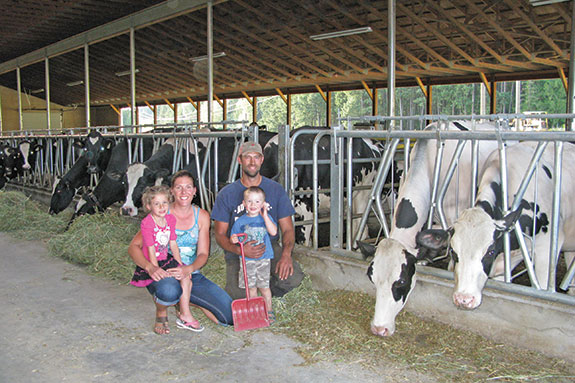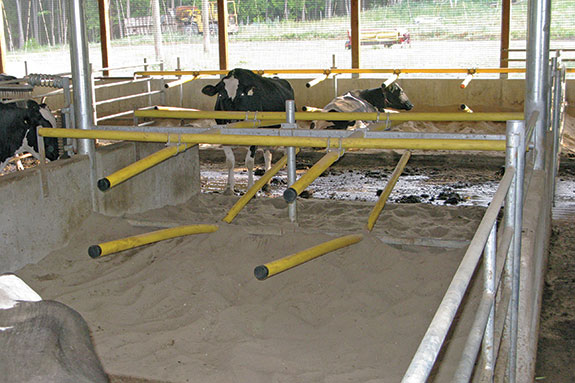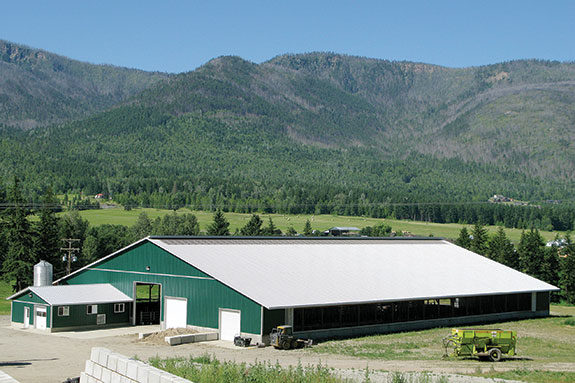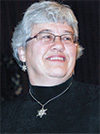It was very labour-intensive, requiring much time in moving cows to the double-three milking parlour, which was separate from the dairy barn.
Cows had to move for feed – inside for alfalfa and to outside bunks for their corn. They kept 45 to 50 cows with breeding and purchasing good cows, but they were going through them faster than they should have.
Although they did the “best we could do with what we had,” Romyn says, their best did not cater to cow comfort, as the freestalls were too short and the cows spent too much time standing around.
{socialbuttons}They also had to travel 150 feet down a concrete path to the parlour, which meant more standing and waiting for their turn to be milked.
This walkway was a problem in winter too, with constant snow build-up and slippery surfaces. Romyn says he “knew (the) cows weren’t doing as well as they could have.”
He knew it was time to make some changes. He was finding it hard to find and keep good help, and he was dissatisfied with the old system, knowing they could be much more efficient.
Most important, he wasn’t able to spend enough time with his wife, Jodi, and young family – daughter, Paige, 5 years old, and son, Grady, 2-and-a-half years old.
The first change was a new calf barn in 2009, with individual stalls for calves from birth to 4 months, after which they move to the main barn.
They are feeding less grain and a more forage-based diet, resulting in calves that are healthier and breeding earlier – at 12 to 13 months – and calving by 24 months.
A complete new facility built last year has totally revitalized the operation in the seven months since moving in. A new 170-by-120-foot barn was constructed, situated to take advantage of natural light and the area’s crosswinds.
Although it required moving a lot of dirt and gravel to accomplish this, Romyn says it was worthwhile due to a great improvement in light and ventilation compared to the old barn. Eight-foot curtains also aid in maintaining fresh airflow.
Milking cows are housed along one side of the barn and heifers and dry cows along the other side. Fresh cows and close-up cows have their own pen areas.
Eight-foot skylights provide a bright interior to the barn. They are augmented by lights situated over the feed alley, which encourages higher feed intake. Romyn says the lighting improvement “makes a big difference in feed consumption.”
An automatic milking system is situated one-third of the way along the barn beside a 20-foot-wide crossover area, designed to eliminate cows standing and blocking access to the robot.
The barn is a free-flow design, where cows can move freely from one area to the next. In its position, the robot is capable of routing cows from any pen so there is less fighting for position among the herd.
Everything the cows need is close at hand – no longer do they need to walk a concrete alleyway for milking or feeding. There is rubber flooring in areas where cows congregate, easing stress on feet and legs. The Romyns also installed a hanging brush for self-grooming. “Cows (were) never cleaner,” Romyn says.
Larger stalls, measuring 9 feet by 4 feet, comfortably accommodate the registered Holstein herd. The Romyns had previously used mattresses and sawdust bedding in the old barn but had trouble with severe mastitis and swollen hocks.
They changed to sand while still in the old barn, with far less trouble, and chose to continue using sand in the new facility. Cows are clean and comfortable, and mastitis issues are rare.
Dry-cow freestalls are 52 inches wide and constructed of flexible composite tubing for increased give.
Calving pens include headlocks in the event they are needed.
All these facility changes have led to management changes. Romyn can now spend more time planning rations while utilizing the precision-feeding option of a robotic milking system.
Stalls and crossovers are cleaned three times a day instead of twice. With alley scrapers running eight times a day, the cows are cleaner and healthier than before.
This is reflected in a remarkable improvement in milk production.
In the old barn, cows averaged 33 to 34 kilograms of milk per cow per day – and have jumped to a new average of 52 kilograms of milk per cow per day. This is more milk with 34 cows than previously with 50.
The cows adjusted really well to the robot and the new barn; the expectation was for their production to be down for approximately six months, but in reality, they were only down for one milking.
By the second milk pickup, production was already heading up. The cows are now averaging 4.4 milkings per day on the robot.
The present herd numbers 34 milking cows plus heifers and dry cows, all of which are registered Holsteins. The herd is on the DHI (Dairy Herd Improvement) program. All are type-classified, with one EX, 17 VG and 22 GP ratings.
Romyn has handled breeding himself since 1998, aiming for 12 hours after standing heat to inseminate. He has a pregnancy rate of 22 percent with a conception rate of 50 percent.
He uses top sires and genotypes his calves, which he feels increases his chances of choosing the “right” mating for his cows. He chooses bulls with functional traits for both conformation and performance.
The Romyns’ farm consists of 160 acres, on which they grow feed for their youngstock and dry cows. Hay for the dairy is purchased both locally and from Alberta, and corn for silage is purchased from a local grower.
They feed a partial mixed ration of 53 pounds corn, 9 pounds hay, 3 pounds straw and 14 pounds dairy supplement. Cows also receive up to 21 pounds of an energy pellet, as determined by their milk production, when they enter the automatic milking system. The herd average for the pellets is around 17.5 pounds.
There is no pasture for the milking herd, but dry cows and youngstock will have pasture by next season.
How has Romyn’s life changed? “I wouldn’t say I’m working less, but it’s a lot more flexible,” he comments. He still gets up early, checks the computer to see if anything is out of ordinary, then does his morning chores of feeding calves, cleaning stalls and mixing feed.
Best of all, though, he is able to spend more time with his family, including meals. He gets to see his kids before bedtime, and he is able to coach his daughter’s T-ball team, which he wouldn’t have been able to do beforehand.
He has time to develop outside interests, like competitive slow pitch – both league and tournaments, which he calls a “nice stress relief for me.”
He said before, “If my cows were happy, it would make my life a lot easier.” Now his cows are happier, and his life is indeed easier. PD
Alice Guthrie is a freelance writer from Hagersville, Ontario.
PHOTOS
TOP: It took a lot of dirt and gravel, but Brad Romyn was able to position his new 170-by-120-foot barn in a location that would capture natural light and the area’s crosswinds.
MIDDLE: Thanks to the flexibility of robotic milking, Brad Romyn, right, can spend more time with his family, left to right, daughter, Paige; wife, Jodi; and son, Grady.
BOTTOM: Composite tubing provides extra give and comfort as dry cows move around in the stall. Photos courtesy of Romyn Hill Farm.










